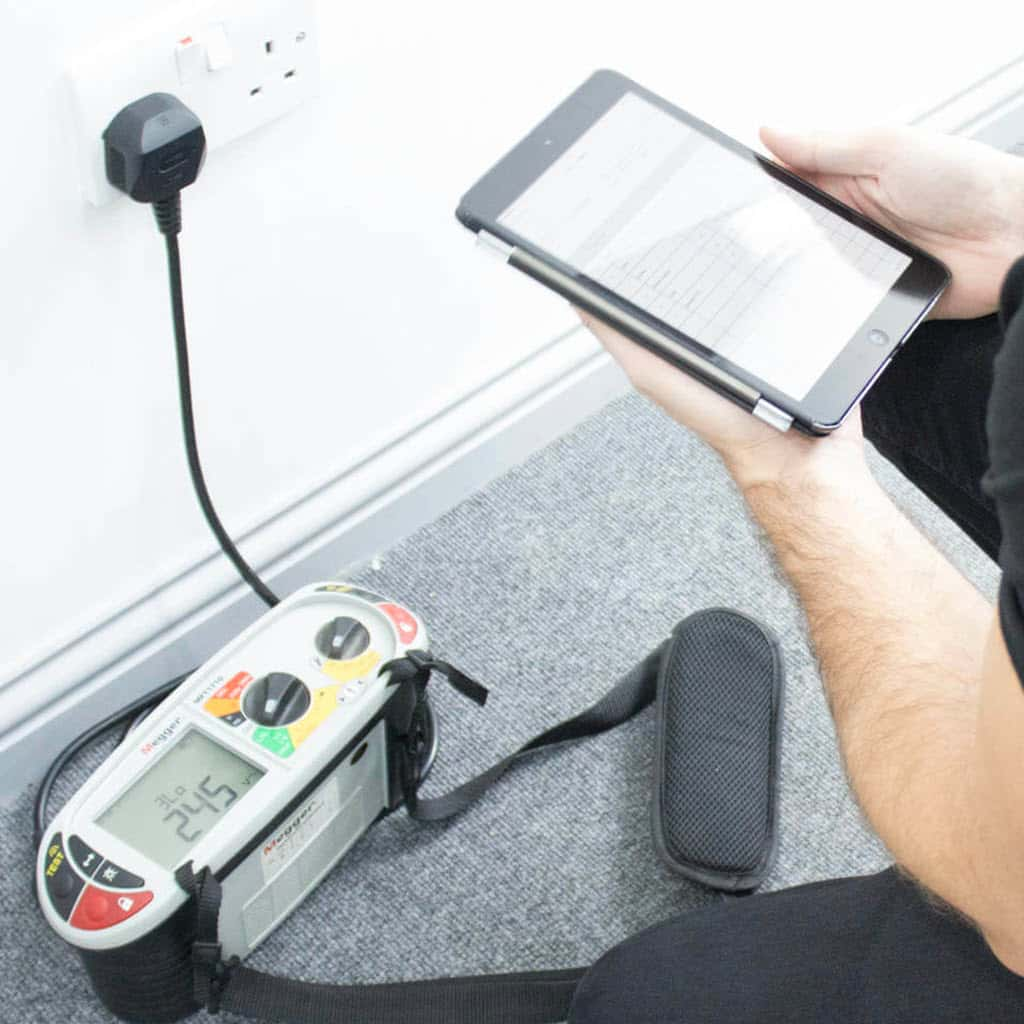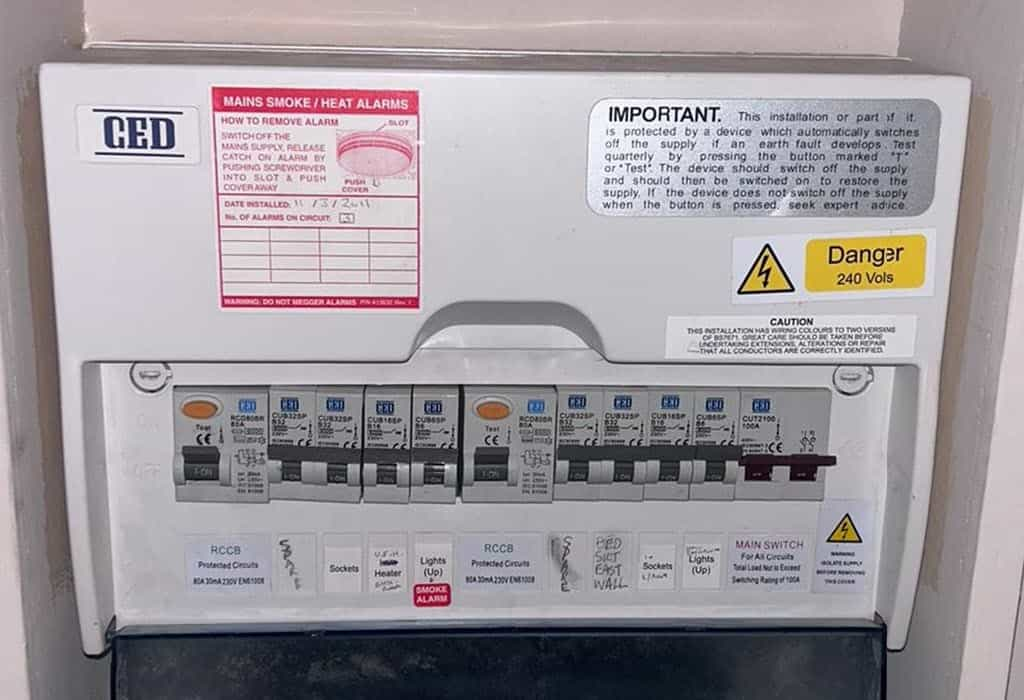As a leading electrical contractor in Edinburgh, we are regularly (pretty much daily) asked questions by landlords and property managers about EICR regulations and good practice for Scottish domestic properties. Here is a range of these questions and the answers we give.
Quicklinks to the Q&As covered:
- What is an EICR?
- What is the law for Scottish landlords and why is this in place?
- What Does an EICR Involve?
- Who is qualified to carry out an EICR in Scotland?
- Do I need an EICR?
- How do I get an EICR?
- Does a plastic fuse box or consumer unit fail an EICR?
- What Happens if I need Remedial work and what do the EICR codes mean?
- Do you need RCD protection to pass an EICR?
- What is the difference between EIC and EICR?
- What Can Fail an EICR?
- What does an EICR check?
- Who needs an EICR and other related questions
- How long does an EICR last?
- How long does an EICR take?
- How much does an EICR cost?
- Do I need a new EICR for a new tenant?
- Do I need an EICR to rent my house?
What is an EICR?
An electrical installation condition report (EICR) is a detailed assessment of a property’s electrical installations. It evaluates the condition of the wiring, circuits, and overall electrical infrastructure, identifying any damage, wear and tear, or potential risks.
The purpose of an EICR report is to ensure that the electrical systems are safe and comply with current regulations, helping to prevent electrical accidents such as shocks, fires, and other dangers.
What is the law for Scottish landlords and why is this in place?
In Scotland, landlords are legally required under the Housing (Scotland) Act 2006 to ensure that their rental properties have safe electrical installations. This includes obtaining an EICR at least every five years, or more frequently if recommended by a previous electrical report.
This regulation is designed to protect tenants from electrical hazards and ensure a safe living environment. Regular inspections help identify and address issues before they become serious problems, thereby reducing the risk of electrical accidents.
What does an EICR involve?
An EICR involves inspection and testing of the electrical installations in a property. The process begins with a visual inspection of all electrical installations, where the electrician checks for any visible signs of damage, deterioration, or unsafe conditions.
Following the visual inspection, the electrician carries out tests on fixed electrical circuits and systems to detect any faults or potential issues. This includes checking the condition of the wiring and electrical accessories to ensure they are functioning correctly and safely.
The suitability of the switchgear and control gear is also evaluated, ensuring that these components meet current safety standards. Throughout the inspection, the electrician identifies any potential risks that could pose a danger to the occupants.
Upon completion of the inspection, a detailed report is provided, which includes observations, EICR codes and recommendations for any necessary remedial work. This report serves as a crucial document for landlords, outlining the steps needed to ensure the electrical installations remain safe and compliant with regulations.

Who is qualified to carry out an EICR in Scotland?
In Scotland, an EICR must be carried out by a qualified electrician who is accredited with SELECT (Scotland’s Electrical Trade Association) or NICEIC (National Inspection Council for Electrical Installation Contracting). This ensures that the electrician has the necessary expertise and qualifications to conduct a thorough and accurate inspection.
If your test certificate is issued by a company that is not a member of these organisations, it will not meet the Scottish Government new repairing standard.
Do I need an EICR?
Yes, if you are a landlord in Scotland, you are required by law to obtain an EICR for your rental property at least every five years.
How do I get an EICR?
To get an EICR, you need to:
- Contact a qualified and registered electrician or electrical contractor, such as our team at Ideal Electrical Solutions (UK) Ltd, who are accredited by SELECT or NICEIC.
- Schedule an appointment for the inspection and ensure the electrician has access to all areas of the property where electrical installations are present.
- After the inspection, review the report provided by the electrician and promptly address any recommended remedial work. Ideal normally issue the EICR report on the same day of the test, along with the invoice, quote and any information you require to book in any remedial work.
Does a plastic fuse box or consumer unit fail an EICR?
A plastic consumer unit does not automatically result in a failure during an EICR inspection. However, it will be closely evaluated for any safety risks. If the plastic consumer unit is in poor condition, lacks an adequate IP (Ingress Protection) rating, or fails to provide sufficient protection, it may be flagged with a EICR Code C2.
A Code C2 indicates that the consumer unit poses a potentially dangerous condition and requires urgent remedial action, including replacement.
Modern electrical safety regulations recommend the use of metal consumer units due to their superior fire resistance and overall safety features. Metal units are less likely to catch fire and can better contain any electrical faults, thereby reducing the risk of fire spreading within the property.
This transition towards metal consumer units is part of a broader effort to enhance the safety of electrical installations and protect occupants from potential risks.
Landlords should consider upgrading to a metal consumer unit to align with current safety standards and ensure the highest level of protection for their properties and tenants.

What Happens if I need remedial work and what do the EICR codes mean?
If your EICR identifies the need for remedial work, you must address the issues promptly. The EICR will use a coding system to indicate the severity of the issues:
Code C1: Danger present, risk of injury – immediate action is required. You can find more on EICR C1 codes here.
Code C2: Potentially dangerous – urgent remedial action is required. You can find more on EICR C2 codes here.
Code C3: Improvement recommended. – not immediately dangerous but safety could be better. More on C3 codes here.
Code FI: Further investigation required. Basically more detailed examination needed to determine the condition. Find out more about FI codes here.
Do you need RCD protection to pass an EICR?
Yes, to rent your property in Scotland, you must comply with the new Scottish Government repairing standard, which includes having RCD protection. Residual Current Device (RCD) protection is strongly recommended for all circuits to enhance safety.
What is the difference between EIC and EICR?
An EIC (Electrical Installation Certificate) is issued for new installations or significant installations, confirming that the work complies with safety standards.
An EICR (Electrical Installation Condition Report) is a detailed assessment that examines the condition of existing electrical installations, ensuring they remain safe and compliant over time.
What can fail an EICR?
An EICR can fail due to several factors, each posing significant safety risks. One common cause is damaged or deteriorated wiring, which can result from age, wear and tear, or external damage.
Faulty electrical connections are another major issue; these can create poor contact points, leading to overheating and potential fire hazards. Additionally, the absence or inadequacy of protection devices, such as fuses, circuit breakers or RCBOs, can prevent the electrical system from safely handling overloads and short circuits.
Correct earthing and bonding are essential for safety, and their absence can increase the risk of electric shock.
Lastly, unsafe electrical installations or equipment, whether due to poor installation practices, non-compliance with current regulations, or the use of substandard materials, can also cause an EICR to fail.
Each of these factors is checked during the inspection to ensure the electrical installations are safe and compliant.
What does an EICR check?
An EICR checks various aspects of electrical installations to ensure safety and compliance with regulations. The inspection includes an evaluation of the condition of wiring and connections, looking for any signs of damage or deterioration that could pose a risk. It also assesses the suitability and condition of switchgear and control gear, ensuring these components are functioning correctly and safely.
Additionally, the EICR examines the adequacy of earthing and bonding, which are crucial for preventing electric shocks. The presence and condition of protective devices, such as fuses and circuit breakers, are checked to ensure they can effectively manage electrical faults.
Lastly, the inspection identifies any signs of wear and tear, damage, or other unsafe conditions that need to be addressed to maintain the safety of the electrical installations.
Who needs an EICR?
Landlords of rental properties are required by law to obtain an EICR. Additionally, homeowners, commercial property owners, and those responsible for public buildings may also benefit from regular EICRs to ensure electrical safety.
How long does an EICR last?
An EICR is valid for up to five years, provided there are no significant changes to the electrical installations during that time. More frequent inspections may be required if recommended by a previous report.
How long does an EICR inspection take?
The duration of an EICR depends on the size and complexity of the property. Typically, an inspection for a standard domestic property can take between 1 to 2 hours. Larger or more complex properties may take longer.
How much does an EICR cost?
The cost of an EICR can vary based on factors such as the size of the property, the complexity of the electrical systems, and the rates charged by the electrician. On average, you can expect to pay between £150 and £300 for an EICR for a standard domestic property.
Do I need a new EICR for a new tenant?
You do not need a new EICR for each new tenant if the existing report is still valid and no significant electrical work has been carried out since the last inspection. However, it is good practice to check the condition of the electrical installations before a new tenant moves in.
Do I need an EICR to rent my house?
Yes, to legally rent out a property in Scotland, landlords must have a valid EICR. This ensures that the property meets electrical safety standards and provides a safe living environment for tenants.
Conclusion…
In this latest article in our series on EICRs we have covered the most frequent questions that we are asked by landlords and property managers. We hope you have found it useful.
If you have any questions then please do give us a call on 0131 258 2750.
All the best
Mark and the IES team.


Great article! I really appreciate the clear and detailed insights you’ve provided on this topic. It’s always refreshing to read content that breaks things down so well, making it easy for readers to grasp even complex ideas. I also found the practical tips you’ve shared to be very helpful. Looking forward to more informative posts like this! Keep up the good work!
Hi Lloyd,
Thank you! Glad you found it helpful. I appreciate your feedback and support. Let me know if there’s anything specific you’d like to see in future posts!